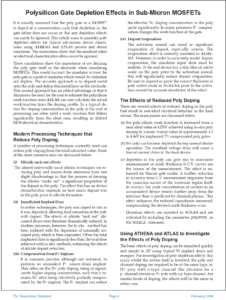Polysilicon Gate Depletion Effects in Sub-Micron MOSFETs
It is usually assumed that the poly gate in a MOSFET is doped at a concentration such that depletion in the gate either does not occur or that any depletion effects can safely be ignored. This article aims to quantify poly depletion effects for typical sub-micron device dimensions using ATHENA and ATLAS process and device simulators. The simulations show that the resultant effect on electrical characteristics often cannot be ignored.
These simulations show the importance of not defining the poly gate itself as the electrode when simulating MOSFETs. This would instruct the simulator to treat the poly-gate as a perfect conductor which would by definition not deplete. The accurate approach is to deposit metal onto the poly and define this metal layer as the electrode. This second approach has an added advantage in that it eliminates the need for the user to estimate the polysilicon work function since ATLAS can now calculate the actual workfunction from the doping profile. In a typical device the doping concentration in the poly at the end of processing can often yield a work function that differs significantly from the ideal case, resulting in shifted MOS electrical characteristics.



